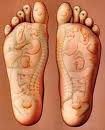Reflexology is a popular alternative therapy. It promotes relaxation, improves circulation, reduces pain, soothes tired feet, and encourages overall healing by reducing stress and allowing the body to balance itself naturally.
Reflexology is a form of bodywork that focuses primarily on the feet and hands.
The theory on how reflexology works is that points on the soles of our hands and feet correlate with organs and other body systems.
A scientific explanation is that the pressure may send signals that balance the nervous system or release chemicals such as endorphins that reduce pain and stress. When this happens you relax and feel good. This treatment is not to replace, treat or diagnosis any medical conditions.
Your session is an 1/2 hour to a hour in length. This includes your hands and feet being worked on. You can be either sitting in a reclining chair or laying on a massage table. The only article of clothing that is removed is your shoes and socks. A brief medical form is filled out. The pressure should be firm, if it is to hard please let your practitioner know so they can adjust the pressure to a more comfortable pressure.
Why do people get reflexology?
Stress and stress-related conditions 
- Tension headaches
- Digestive disorders
- Arthritis
- Insomnia
- Hormonal imbalances
- Sports injuries
- Menstrual disorders, such as premenstrual syndrome (PMS)
- Digestive problems, such as constipation
- Back pain
Reflexology is also used for post-operative or palliative care. A study in the American Cancer Society journal found that one-third of cancer patients used reflexology as a complementary therapy.
Reflexology is recommended as a complementary therapy and should not replace medical treatment.
What is a typical reflexology treatment like
A typical treatment is 45 minutes to 60 minutes long and begins with a consultation about your health and lifestyle.
You are then asked to remove your shoes and socks and sit comfortably in a reclining chair or on a massage table. Otherwise you remain fully clothed.
The Reflexologist will assess the feet and then stimulates various points to identify areas of tenderness or tension.
The Reflexologist then uses brisk movements to warm the feet up. Then pressure is applied from the toes to the heel according to your comfort.
Lotion or oil may be used.
How will I feel after?
Most people feel calm and relaxed after a treatment. They may even feel sleepy.
Occasionally, people feel nauseous, anxious, or tearful, but this is only temporary and is considered to be part of the healing process
